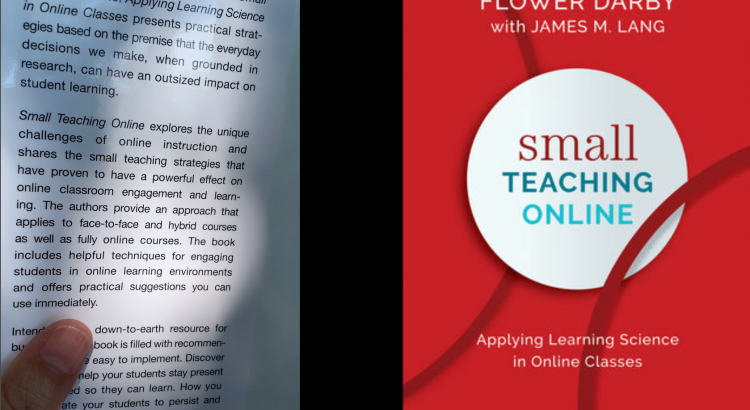by Liz Evans
A new book, Small Teaching Online: Applying Learning Science in Online Classes, by F. Darby and J. Lang (Wiley 2019) caught my eye last June, initially via this IHE author interview. The timing of this discovery was perfect for me, since I was helping to support LACOL’s first fully online summer data science class. So many nuggets from this book prove to be right on target for LACOL’s various pedogogical explorations, I choose it as something to share with my awesome colleagues on the Haverford College Instructional Technology team as part of their summer 2019 Learn and Share discussion group. This short review highlights some of the authors’ ideas I found most thought provoking and potentially useful to anyone teaching in the classroom, online … or both!
Many faculty and designers may be familiar already with the phrase “small teaching” which was made famous in Prof. James Lang’s 2016 book, Small Teaching: Everyday Lessons From the Science of Learning. In a nutshell, Lang demonstrates how small, easily-managed teaching modifications – based on the neuroscience of how people learn – can have a positive impact for students. That is, small adjustments can make good teaching great.
Online professor and instructional designer Flower Darby worked with Lang to bring the small teaching concept into the online realm. The opportunities for discovery are rich because, as Darby notes, online learning is in its infancy.
The book recommendation is excellent – a lot of useful suggestions which would take years to figure out.
-Dr. Natalia Toporikova, Washington and Lee University; online data science instructor, summer 2019, 2020
As anyone experimenting with online teaching can tell you, there are plenty of synchronous and asynchronous ways to foster engagement. However, doing this well takes some different habits of organization and preparation online compared to managing a typical face-to-face classroom. Certain adjustments are needed due to the absence of non-verbal cues which are so common in physical spaces, we take them for granted. As Small Teaching Online explains, “when you have lots of time to spend with your students in a face-to-face environment, you have frequent informal opportunities to remind them about the larger purpose of the course, connect the classroom activities to the course learning objectives, and provide the reasoning behind your assessments.”
Compared to how long we’ve been teaching in person, online learning is in its infancy.
-F. Darby, Author
Subtle classroom cues may get lost in the ether, so online teachers need to work deliberately and creatively. Through text, voice, and media, faculty can lead and collaborate with students to establish free-flowing dialogues, frequent checkins via lightweight feedback, and, most importantly, social presence. Small measures, artfully applied, can help to solve common grumbles about online classes, which can feel – at times – like static walls of text, links, and task lists.
To craft active, richly human digital spaces, style and tone matter a lot. Small self-reflections, and some good humor, can go a long way to infusing an online course with personality, hopefully – as one of our summer professors put it: “in a non-annoying way.”
Tried and true pedagogical approaches such as Universal Design and Backwards Design can be tweaked to meet online needs. For example, since the progression and purposeful linkages between class activities can be more opaque to online students, the authors suggest offering small clues early on to preview the final class assessment. That way, students can approach each step of the class with an eye for how they will bring all they’ve learned together for the final paper, test, or project.
The most important imperative explored in Small Teaching Online is for faculty and tutors to be present. As Darby says, “no amount of sophisticated bells and whistles can replace an authentic, present and engaged instructor.” Establishing presence and social learning through multi-modal engagements and reflective meta-cognition are effective techniques for *any* class, both face-to-face and through the internet. Communicating the underlying what, why and how of learning is especially important for online learning success. And, like any important new skills, acquiring these capabilities takes planning and practice.
Related Resources:
- Small Teaching Online – Table of Contents and Chapter 1 (PDFs)
- How to Be a Better Online Teacher: Advice Guide (F. Darby, Chronicle, July 2019)
- F. Darby website: https://flowerdarby.com/
- Podcast, B. Stachowiak with F. Darby: https://teachinginhighered.com/podcast/small-teaching-online/




